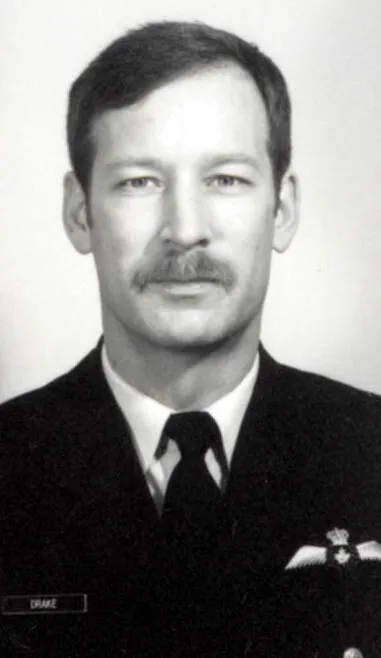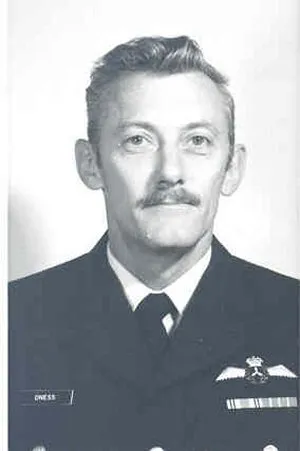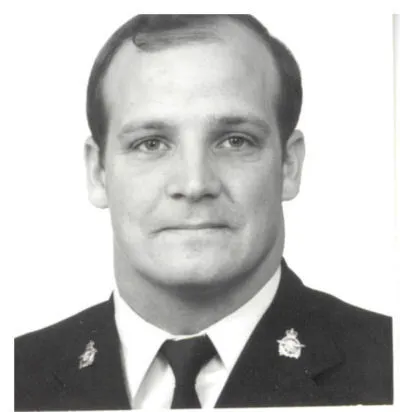Mahaffey, Iain David (Captain)
Killed in Flying Accident 1985-March-29


Birth Date: 1958-April-18
Born: Montreal, Quebec
Parents: Son of Dvid Herbert and Esther (nee McKernan) Mahaffey of Kingston, Ontario.
Spouse: Husband of Mireille (nee Rose) Mahaffey and father of Ashley and Stephanie Mahaffey of Winnipeg, Manitoba.
Home: Montreal, Quebec
Enlistment: Ottawa, Ontario
Enlistment Date: 1980-March-12
Service
RCAF
Unit
429 Sqn- Squadron
Fortunae Nihil Nothing to chance
Base
Rank
Captain
Position
Service Numbers
B/21533256
Crew or Other Personnel
Hercules 130331
Mission
Hercules CC-130H 130331
Ferry Flight 1985-March-29 to 1985-March-29
() (RCAF)
Two Lockheed CC-130H Hercules transport planes were destroyed in an accident following a mid-air collision over Edmonton-Namao Field, AB (YED), Canada. All five crew members aboard each plane were killed.
The aircraft were part of the three-ship formation taking part in a fly-past to mark the 61st anniversary of the Royal Canadian Air Force.
Hercules serial: 130331
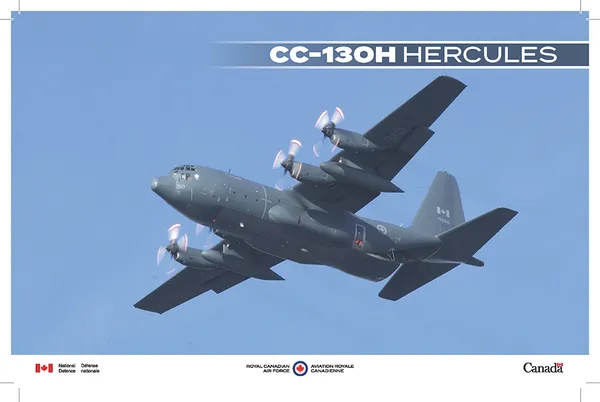
(Source RCAF Web Page)
Unit Desciption
429 Sqn Fortunae Nihil ("Bison")
History of the Squadron during World War II (Aircraft: Wellington III, X, Halifax II, V, III, Lancaster I, III)
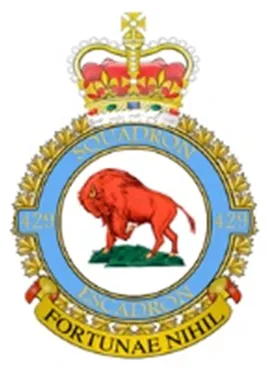
No 429 Squadron was the 10th bomber unit and 27th squadron formed by the RCAF overseas in WWII. It was formed in November 1942 at East Moor, Yorkshire, UK ![]() as part of No 4 Group of RAF Bomber Command. On April 1, 1943 it became part of No 6 (RCAF) Group at No 62 (RCAF) Base, still remaining at East Moor until August 1943, when it moved to Leeming, Yorkshire
as part of No 4 Group of RAF Bomber Command. On April 1, 1943 it became part of No 6 (RCAF) Group at No 62 (RCAF) Base, still remaining at East Moor until August 1943, when it moved to Leeming, Yorkshire ![]() as part of no 63 (RCAF) Base: it remained at Leeming until its disbandment in May 1946. It undertook strategic and tactical bombing operations. After the cessation of hostilities in Europe, it remained in England and transferred to No 1 Group, where it was engaged in transporting troops from Italy (Operation DODGE).
as part of no 63 (RCAF) Base: it remained at Leeming until its disbandment in May 1946. It undertook strategic and tactical bombing operations. After the cessation of hostilities in Europe, it remained in England and transferred to No 1 Group, where it was engaged in transporting troops from Italy (Operation DODGE).
The squadron, with squadron code AL, flew Vickers Wellington Mks III and X until August 1943, when it re-equipped with Handley-Page Halifax Mk II, which it flew between August 1943 and January 1944, and Mk V between November 1943 and March 1944. These were superseded by Halifax Mk III aircraft in March 1944. In March 1945, the squadron re-equipped with Lancaster Mk I and III. In summary of its activities, it flew 3221 sorties, including airlifting 1055 PoWs back to England, for the loss of 71 aircraft. 9356 tons of bombs were dropped. The squadron was awarded45 DFCs and 2 Bars to DFC, 1 AFC, 1 CGM and 7 DFMs. Battle Honours were: English Channel and North Sea 1943-45, Baltic 1943-45, Fortress Europe 1943-44, France and Germany 1944-45, Biscay Ports 1943-44, Ruhr 1943-45, Berlin 1943-44, German Ports 1943-45, Normandy 1944, Rhine, Biscay 1943-44. Wikipedia,Moyes, Kostenuk and Griffin
Squadron History (Bomber Command Museum PDF)
Maps for Movements of 429 Squadron 1942-46
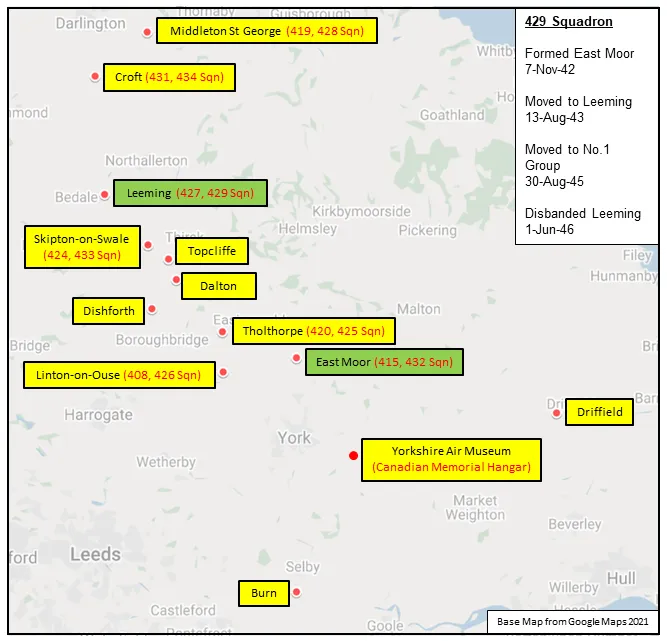
429 Squadron History Summary 1942-46
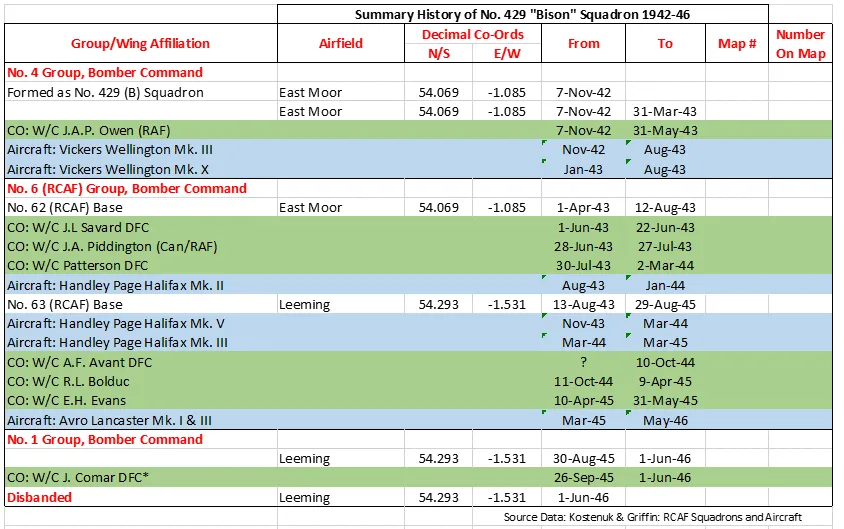
History of the Squadron Post-WWII (Aircraft: Buffalo, Hercules, Globemaster)
The squadron was reactivated at St. Hubert, Quebec ![]() on 21 August 1967 as a Tactical Transport Unit. It flew de Havilland CC-15 Buffalo aircraft for the Canadian Forces Mobile Command and was integrated into the Canadian Armed Forces on 1 February 1968. In August 1981 it was renamed 429 Transport Squadron and moved to CFB Winnipeg
on 21 August 1967 as a Tactical Transport Unit. It flew de Havilland CC-15 Buffalo aircraft for the Canadian Forces Mobile Command and was integrated into the Canadian Armed Forces on 1 February 1968. In August 1981 it was renamed 429 Transport Squadron and moved to CFB Winnipeg ![]() . The final move was in 1990 to 8 Wing in Trenton, Ontario
. The final move was in 1990 to 8 Wing in Trenton, Ontario ![]() . The squadron was disbanded in 2005.
. The squadron was disbanded in 2005.
Two years later in August 2007, 429 Squadron was again re-activated, this time operating the CC-177 Globemaster III strategic transport aircraft. It used these new aircraft in support of Canada's operations in Afghanistan.
